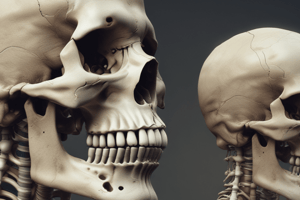Podcast
Questions and Answers
What is the name of the contribution that forms most of the outer casing of the skull in later vertebrates?
What is the name of the contribution that forms most of the outer casing of the skull in later vertebrates?
- Pharyngeal slits
- Dermal bones (correct)
- Visceral cranium
- Endochondral bone
Which part of the skull is composed of endochondral bone or of cartilage, or both?
Which part of the skull is composed of endochondral bone or of cartilage, or both?
- Splanchnocranium
- Dermatocranium
- Neurocranium
- Chondrocranium (correct)
What term is used as an equivalent to the chondrocranium by some morphologists?
What term is used as an equivalent to the chondrocranium by some morphologists?
- Braincase
- Pharyngeal slits
- Neurocranium (correct)
- Dermal bones
Which part of the skull is composed of fused cranial components surrounding and encasing the brain?
Which part of the skull is composed of fused cranial components surrounding and encasing the brain?
What is the most ancient part of the skull that first arose to support pharyngeal slits in protochordates?
What is the most ancient part of the skull that first arose to support pharyngeal slits in protochordates?
What structures can make up the braincase in different species?
What structures can make up the braincase in different species?
What parts can some morphologists expand the term 'neurocranium' to include?
What parts can some morphologists expand the term 'neurocranium' to include?
What do still others consider the neurocranium to be?
What do still others consider the neurocranium to be?
Flashcards
Dermal Bones
Dermal Bones
Dermal bones form most of the outer casing of the skull in later vertebrates.
Chondrocranium
Chondrocranium
The chondrocranium is composed of endochondral bone or of cartilage, or both.
Braincase
Braincase
The braincase is composed of fused cranial components surrounding and encasing the brain.
Splanchnocranium
Splanchnocranium
Signup and view all the flashcards
Braincase Composition
Braincase Composition
Signup and view all the flashcards
Study Notes
Skull Structure and Terminology
- The contribution that forms most of the outer casing of the skull in later vertebrates is known as the dermatocranium.
- The chondrocranium is the part of the skull composed of endochondral bone, cartilage, or a combination of both.
- Some morphologists use the term chondrocranium as an equivalent for the cartilaginous skull.
Braincase and Skull Components
- The neurocranium encompasses the fused cranial components that surround and encase the brain, providing structural protection.
- The most ancient part of the skull, which originated to support pharyngeal slits in protochordates, is referred to as the olfactory capsule.
- In various species, the braincase can be made up of structures such as cartilage, endochondral bones, and dermal bones.
Expansions of Skull Terminology
- Some morphologists expand the term neurocranium to include additional structures such as facial bones and other components involved in cranial development.
- Other scholars consider the neurocranium strictly as the portion that directly encases the brain, without considering the surrounding components.
Studying That Suits You
Use AI to generate personalized quizzes and flashcards to suit your learning preferences.




